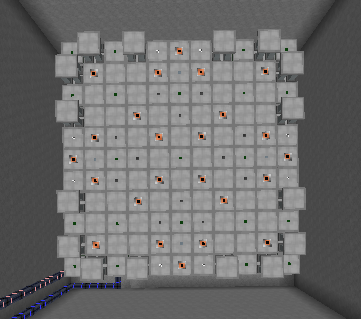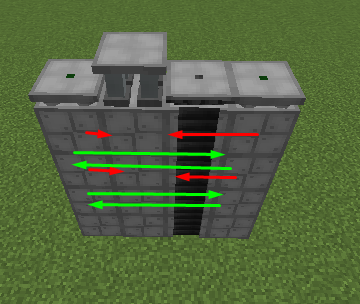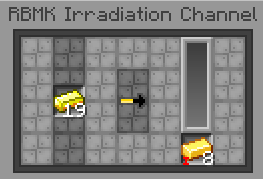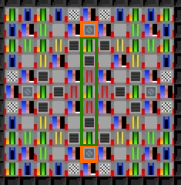майнкрафт мод nuclear tech
Майнкрафт мод nuclear tech
See: Category:Nuclear Fuel to find out what fuels the RBMK can use and what stats they have.
Functional RBMK reactor in operation.
The RBMK (Russian: реактор большой мощности канальный, РБМК; reaktor bolshoy moshchnosti kanalnyy, «high-power channel-type reactor») is a type of nuclear fission reactor added in version 1.0.27 X3864 (1.7.10). It is a highly modular reactor with a theoretically infinite size (if your computer can handle it), with several components, each being 4 blocks tall by default, which can be changed using the dialColumnHeight gamerule (2-16, purely aesthetic). The reactor can output several types of steam, each of which requires a higher temperature to produce. These range from normal steam to ultra dense steam. This reactor requires no coolant, as it is a BWR (boiling water reactor), as opposed to a PWR (pressurized water reactor, which the other two fission reactors are), since heat is both transferred directly to the boilers and is passively removed. It also has a console that allows for remote management of several elements from far distances. This reactor has the capability of running on numerous types of fuels (many unavailable to the other two reactors), along with a novel meltdown function unique to itself.
Contents
Component Blocks
Fuel Rods
The most important part of a reactor; it is impossible to run one without this block. Reactors take a single fuel rod, while also taking in and outputting neutrons depending on the fuel. When fuel reacts and heats up, the block follows at a slightly lower skin temperature. This is important, as you can use this with steam channels to output steam for power generation. If the fuel inside exceeds its melting temperature, then a meltdown will occur and fill a wide area with radiation (tested with a small reactor, over 10k rads at the epicenter).
In a reactor, there are 3 basic states: subcritical, critical, and supercritical. Subcritical means that the fuel in the reactor does not meet the required critical mass of the fuel material and is insufficient to sustain a chain reaction, so it will fizzle out and stop. Critical means that it can sustain a stable chain reaction and continue to react continuously. Supercritical means that the chain reaction is unstable and will continue to rise in reactivity until meltdown. It’s important to use ideal neutron flux levels for each fuel, to make sure it is critical. A fuel or fuel setup that is known to be «self-sustaining» are capable of maintaining criticality without becoming sub or supercritical.
Come in moderated variants, which automatically slows down incoming neutrons, removing the need for a moderator columns. Requires Bismuth to make however, which means you would need to run and deplete a lot of RBMK fuel already.
Fuel Rod Item
The fuel rod item is the actual rod that contains the fuel and will generate heat and flux. Each fuel rod type has a plethora of information given out, here’s the most important aspects of what you need to know about them, other parts will be discussed later:
Flux Function Types
(If the fuel is self-igniting, it is automatically self-sustaining; Fuels that are not capable of self-sustaining criticality require a fuel that is to act as a driver, fuels that are theoretically capable of being self-sustaining means that it is possible to attain criticality with them purely, but it may not be practical to attempt it.)
Steam Channels
These are the second most important part of a reactor, as they allow for generating energy with steam turbines and cooling down the reactor. Steam Channels take water, and can be configured to output one of the following steam types:
Steam Connector with proper pipe connections.
Depending on your steam type, you’re going to need to run the reactor at a higher temperature to produce any of said steam. Steam channels also actively cool your reactor down by taking heat from it and using it to make steam, if they are empty they won’t cool it down. Higher compressed steam types also ultimately produce more power and cool more.
Steam connectors, while not necessary, can make your reactor more pretty and realistic looking by connecting both pipes below the reactor instead of one below and one above. They can only be used in the configuration specified by the image attached (in exception to the steam pipe, which can be attached to any face except the top).
Control Rods
Control rod at 50% insertion. Arrows show the flow of neutrons.
Control Rods are an almost essential component to your reactor, which allows you to control the percentage of neutrons that can pass through it, and by consequence, how hot it runs. Some minimalist designs don’t require this due to how the fuel works, but unless you don’t want a meltdown, want to turn it off at some point, or want to control the reaction more precisely, you need to include these. You can change their color group to be able to control them in the console as a group. You can also set them manually, but you shouldn’t really do this in case you have an emergency. All rods displayed in a console are fully inserted when you activate AZ-5.
They are graphite tipped, so there will be spikes in criticality when inserting them below 10%. The spike is dependent on the starting position of the rods, so shutting down at from 100% means there is a brief moment where all neutrons are allowed to pass through. This means that AZ-5 may not be the safest option in all cases.
Come in moderated variants that automatically moderate neutrons passing through. Requires Bismuth to make however, which means you would need to run and deplete a lot of RBMK fuel already.
Automatic Control Rods
Like the control rods, these control the neutron flow in a reactor. However, unlike normal control rods, these are activated by temperature: not by manual control. They have different types of insertion «curves» (actually graphing functions), as well as the ability to set minimum and maximum temperatures for insertion. They are useful for automated reactors running on highly reactive fuel.
Graphite Moderators
These will turn fast neutrons into slow (or thermal) neutrons for use in your reactor. Using the wrong neutron type reduces the reactivity of fuel rods, and could result in drastic inefficiency depending on the size and runtime of any given reactor. Since most fuels require slow neutrons to split, this is also a very important element of any reactor. Some fuels (like Neptunium) require fast neutrons instead, and using a moderator actually decreases their performance.
Neutron Reflectors
Like the name implies, the reflectors send neutrons back to their source, increasing reactions without using more fuel. Depending on the design, this potentially increases efficiency significantly, on the other hand, using too many reflectors could lead to a meltdown if placed recklessly. It may also depend on the setup. Generally speaking, they’re useful to improve performance, but in some cases they may be unwanted or unnecessary.
Neutron Absorbers
Also self explanatory. These act like fully inserted control rods, except you can’t raise them. Useful for sectioning off parts of the reactor so they don’t interact with other parts, perhaps for multi-fuel or other radical designs.
Irradiation Channel
RBMK Irradiation channel used to make Gold-198.
These are basically just a breeding reactor for your RBMK, except with only 2 recipes:
To use them, they have to be irradiated by neutrons from adjacent sources, and have a valid item inside.
Structural Column
These don’t do anything other than transfer heat and passively cool a reactor. Useful to fill empty space between components for better heat distribution.
Console
The console is also a very important element of a reactor. With it, you can manage your reactor remotely, while also able to control several rod groups at the same time. To use it, one needs to use the RBMK Console Linking Device, then linking their reactor to the console. It has an area of 15×15 blocks. This doesn’t mean the reactor can’t be infinite, it means the console can only control that area at any given time. It also has an AZ-5 button, that when pressed, will fully insert all control rods within its control area. It can also set the control rods to more precise percentages, rather than in sets of 25.
Cover Panel/Lid
Cover panels prevent radiation from leaking out of the RBMK. They are no longer spawned on columns by default, so one must craft and place them on the RBMK to prevent radiation from being spewed out. Lead/Boron glass panels are a mostly aesthetic variant; their main benefit is shattering during a meltdown, preventing the panels from acting like a projectile and therefore reducing destruction.
Mechanics
Neutrons
Neutrons are what make fuel split and heat up. Neutrons are generated by fuels marked as self-igniting are in a fuel rod or when fuel is impacted by the right neutron type. Fuel has a tooltip which shows which neutron type it needs to split, as well as what type it splits into. Neutrons only travel horizontally and follow a straight path until they reach another fuel rod or a reflector. Self-igniting fuels generate neutrons automatically, and can react with itself; too many self-igniting fuel rods can lead to a meltdown.
Neutron source rods are a «special» type of self-igniting rod, they do not fission and do not produce a lot of heat on their own. They also deplete quickly, so you should remove it and replace it with a regular fuel rod once the reaction has started to be most efficient.
Fuel rods, when experiencing fission, generate heat. Heat is transferred to adjacent components, and can be used to generate steam for power generation. Components also gradually cool down through passive cooling, which increases depending on how many components your reactor has. This means you should be careful with adding too many structural columns, as it could cool the reactor down beyond any usable temperatures.
Xenon Poison
Xenon-135 is a common product resultant from fission reactions, which can build up in the fuel rods of a reactor and act as an undesirable neutron absorber. Simply put, this is something that slows down fuel reaction when you don’t want it. Xenon «burns» away at higher power, so if your reactor can output enough neutrons, you shouldn’t worry much about it. It may be problematic if you wish to run your reactor at low power however, as it may drop the reaction too much or halt the reaction entirely.
Xenon can also be a problem with certain types of fuels that require an initial neutron flux burst to initiate criticality and become self-sustaining or requires a significant driver to keep it critical. Xenon prevents this initial neutron burst from being as effective and thus requires increased power (ie raised control rods) to burn it off and attain criticality. This means that once the Xenon is burned off, the flux level will be at a level far higher than what would’ve been necessary, potentially causing a meltdown if the reaction doesn’t stabilize itself or by means of lowering control rods.
Fuel Temperature
When fuel reacts, it generates heat, which is shown as core and skin temperature. As stated before, core temperature doesn’t matter too much, as it can be way higher than the skin temperature which is what transfers to the fuel rod block. Skin temperature is almost always higher than the reactor temperature even if you have good cooling due to heat transfer. As long as the skin temperature is nowhere near the melting point of the rod and flux is stable, you should be fine.
Meltdown
RBMK meltdown mid-explosion. Notice the debris flying out.
Probably the most interesting part, a meltdown is when things get out of control and the reactor literally melts. It happens when the skin temperature gets past the melting point of a given fuel, or when a reactor component’s temperature reaches more than 1500 ºC. It explodes violently, releasing debris and high amounts of radiation into the environment. Debris can be collected by hand and will give you the respective debris item. They can’t be processed yet, and are just waste for now. After a meltdown, Corium replaces the fuel rods and is highly radioactive, while regular RBMK debris variants replace the rest of the components. Corium solidifies over time, turning into corium blocks which are fatally radioactive in seconds; cleanup is extremely difficult until they have decayed as a result. Reactor Corium and Sellafite-Corium are not to be confused.
Tips and Trivia
Pros and Cons
Neutral
Design Philosophy
The most important goals of any RBMK reactor is to generate energy whilst preventing a meltdown. Heat is necessary to produce steam in steam channels and heat is generated by fuel rods receiving and outputting neutrons. This means that the most optimal placement for steam channels is somewhere near the fuel rods of a reactor; ideally diagonally from them. However, since neutrons travel horizontally, and most fuel types require slow neutrons to react whilst splitting into fast neutrons, some thought must be placed into where the neutrons in your reactor are going and what type they are. Fuel rods should be placed horizontally from each other. Neutrons that reach the edge of a reactor are wasted, but reflectors can be placed there to reflect neutrons back into the fuel rods, increasing the efficiency of your reactor. If a fuel rod requires slow neutrons, moderators should be placed between it and any other source of neutrons, such as reflectors and other fuel rods.
An RBMK reactor utilizing absorbers.
Preventing a meltdown is important as well, since a destroyed reactor is not very useful. Making the fuel rods of a reactor too reactive or not having enough sources of cooling, will lead to the reactor overheating and causing a meltdown. The primary way to reduce reactivity is control rods; which will reduce the amount of neutrons passing through depending on how much of the rod is inserted. Control rods should be placed between fuel rods and other sources of neutrons, whether it be another fuel rod or a reflector. An alternate way is neutron absorbers. As seen in the example to the right, neutron absorbers can be used instead of reflectors to prevent these three fuel rods from becoming too reactive, since they are receiving plenty of neutrons from other sources.
Steam channels are important for cooling down a reactor. Boiling water into steam takes heat away from the reactor, and as such steam channels should be placed regularly and have enough water to be boiled, lest the reactor overheats. Similarly, since increasing the amount of components in a reactor increases passive cooling, there should also be enough additional columns in a reactor to provide a passive cooling effect.
Designs
There are more designs in the #rbmk-designs channel in the discord server.
(Note that some of these designs were made before critical RBMK fuel changes, and as such, might cause an immediate meltdown or not work at all. Please test the optimal fuel rods and power settings for them before use! This area will be updated soon with better reactor designs.)




